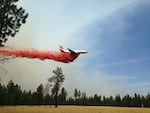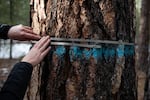
Central Oregon will receive $41.3 million to safeguard forests against wildfires, such as the 2017 Milli Fire near Sisters.
Central Oregon Interagency Dispatch Center
A huge influx of federal funding will be put to work on Central Oregon forests to lower the risk of catastrophic fire next door to growing cities.
The U.S. Forest Service this month announced a $41.3 million investment in fire treatment on 50,000 acres of public lands in the region, most of it in the Deschutes National Forest.
The money will pay for fuels reduction through selective logging, mowing of underbrush and prescribed burning as well as native plant restoration, habitat improvements and watershed enhancement on forestland directly west of Bend, La Pine and Sisters over the next three years.
“This is a huge deal,” said Jean Nelson-Dean, public affairs officer for the Deschutes National Forest. “This will definitely allow us to accelerate the pace and scale of work here, particularly fire reduction and risk reduction around our communities.”
Related: Lessons from the Biscuit, Bootleg, Milli and Rosland megafires
Environmental groups are urging the Forest Service to focus fuels reduction on forestland closest to residential areas and not the backcountry. They’re also advocating for strict size limits to protect larger trees from being removed during logging projects.
A timber sale that was part of a similar project west of Bend drew criticism in March after several larger trees were cut next to a popular mountain biking trail.
“With this funding, the concern is that we’re going to see that type of logging juiced and done on a massive scale,” said Erik Fernandez, wilderness program manager for the conservation group Oregon Wild.
Central Oregon is the fastest-growing region in the state, partly for its proximity to world-class forests and wilderness.
But that closeness also leaves cities at high risk of wildfire. Public land managers in Central Oregon have worked to reduce that risk as fires have grown larger, hotter and more frequent statewide.
Related: Lottery-fueled funding drought hampered fire mitigation before Bootleg
Nelson-Dean said some 450,000 acres on the Deschutes National Forest are in need of fire treatments.
She likened conditions on the Deschutes to those facing the Fremont-Winema National Forest in Southern Oregon, where the Bootleg Fire started last summer before ultimately torching more than 400,000 acres.
“We have that same situation here,” Nelson-Dean said.
She added that the intention of fuel-reduction work is to preserve the healthiest trees in the forest — especially old growth — to guard against wildfire, disease and insects.

FILE: Measuring a ponderosa pine marked for cutting west of Bend. Several conservation groups have called on the Forest Service to restore the 21-inch rule to protect large trees.
Bradley W. Parks / OPB
While visiting the Pacific Northwest on Friday, President Joe Biden signed an executive order that will require the U.S. Department of Agriculture, which oversees the Forest Service, and the U.S. Department of Interior to develop a shared definition of mature and old-growth forests. Older trees provide significant wildlife habitat, carbon storage and fire resistance.
Bend-based Central Oregon LandWatch and Worthy Garden Club are among the groups that have joined Oregon Wild in calling for the “21-inch rule” to be applied to Central and Eastern Oregon forestlands.
The rule, part of the Eastside Screens plan implemented by the Clinton administration, prevented cutting trees larger than 21 inches in diameter at breast height, a common measure of a tree’s size. The Trump administration scrapped the size limit before leaving office last year.
